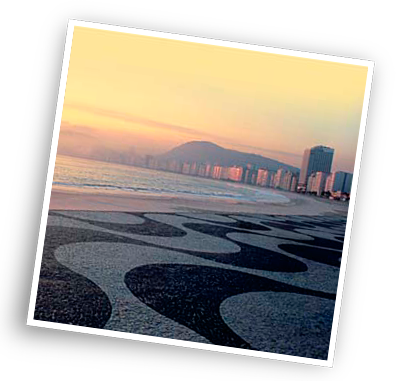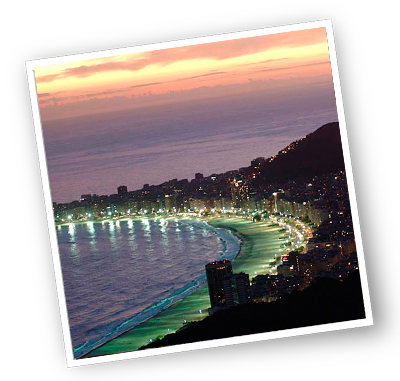The Princess of the Sea
The most famous beach in Brazil and its history...
Source: http://www.marcillio.com/rio/encopaca.html#his
Copacabana, once named Sacopenapã meaning “path of socós“ (a type of bird that inhabited the region), is now the most famous beach in Brazil, known all over the world. Its current name, however, has its origins outside of Brazil, in the then Viceroyalty of Peru, close to Lake Titicaca, in a region which now belongs to Bolivia, where the Spanish erected a chapel to Our Lady of Candelaria, later known as Our Lady of Copacabana. Copies of the image were brought in by “peruleiros“, people who traded silver in the Viceroyalty. The copies were initially taken to the Church of Mercy, currently the Church of Our Lady of Bonsucesso, but were later transferred to a fisherman’s church on the outside of the shoal.
In 1770, Friar Antonio do Desterro would erect a chapel to the saint which remained in place until 1918, when it was demolished and its area annexed to Fort Copacabana.
Until the 19th century, access to Copacabana was made by either one of two slopes: Barroso Slope, currently Tabajaras Slope, and Leme; or by a long journey through the Rodrigo de Freitas Lagoon. The first land proprietor, owning almost the whole neighborhood, was Alexandre Wagner, who purchased three rural properties from 1873 onwards: Boticário, Sobral and Leme Ranches, which extended over from Ponta do Leme to current Siqueira Campos street. Its transformation into a Neighborhood only took place after 1892, with the arrival of the trams by Cia Ferro Carril Jardim Botânico and the opening of the Alaor Prata tunnel, known as Túnel Velho (“old tunnel“), connecting Botafogo to Copacabana, close to São João Batista Cemetery.
In 1904 new tunnels Engenheiro Coelho Cintra and Engenheiro Marques Porto were opened, both together popularly known as Túnel Novo (“new tunnel“), but the neighborhood’s housing boom would happen in the 1930’s, although Copacabana Palace hotel already existed since 1922. Copacabana, together with Ipanema and Leblon form the three affluent waterfront neighborhoods of the city’s South Zone, having their infrastructure established before their occupation. Such occupation has lately expanded to São Conrado and Barra da Tijuca, with the search for new spaces due to the city’s growth.
Copacabana is a neighborhood considered as traditionally bohemian since the occupation of Leme by the end of the 19th century to date, where one can find several bars and restaurants, and a busy nightlife. Its natural beauty is so captivating that its fame has conquered the whole world.
Rio in Box is also a part of this story of cheerfulness and beauty, since 2010 having 2 Shops close to the coast in Copacabana: one at Avenida N. Sra. de Copacabana and another inside Rio Othon Palace Hotel. There the tourist can purchase miniatures of the Christ the Redeemer statue (including in Soapstone, which is the material used in the lining of the actual statue) and the Sugar Loaf, in addition to handicraft items, T-shirts, bags and several gifts with images of the beauty of Copacabana and the famous pattern of its Promenade.
Come visit Copacabana Beach and get to know
Rio in Box Shops in the neighborhood!Back to home page


